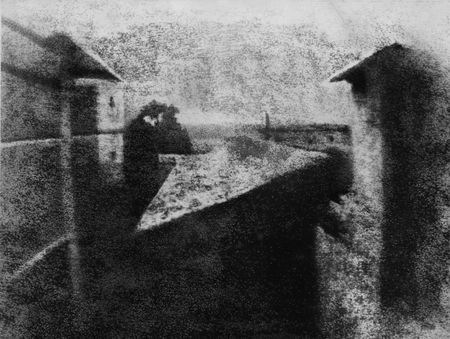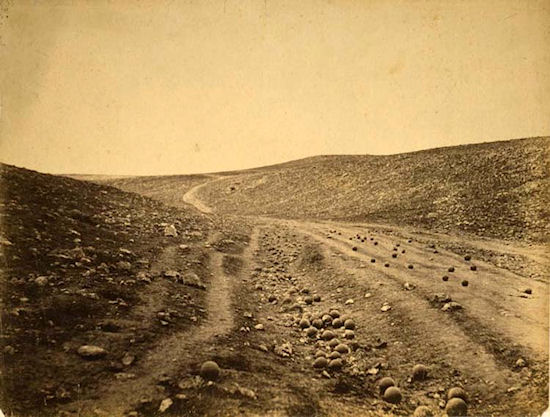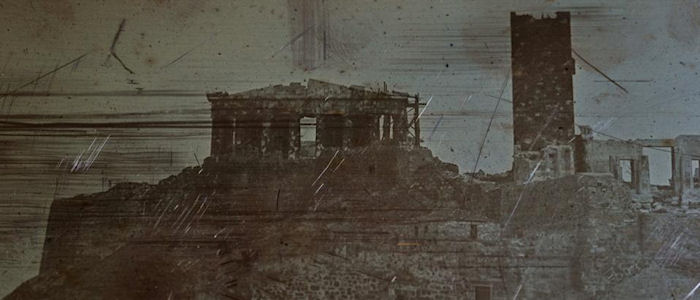There are photos that are really works of art, others that have great historical value, photographs that make people cry or laugh and pictures that overturned governments.
Beyond any doubt, the imprinting of an image is one of the most important achievements of human civilization and one of the few cases where a purely technological and scientific development has given birth to a new form of art.
The following listing presents the most important milestones in the history of photography, from ancient times until today.
4th century BC: (around 350). Aristotle describes how the simplest camera, known as camera obscura, works.
1000 AD: The Arab scholar Alhazen translates the description of Aristotle's machine .
1490: The camera obscura was the first photographic device to be transported. We can not just say a camera because it did not have a film and a lens. Leonardo da Vinci knew about and probably used this construction.
1530: Daniel Barbara places the first lens in an obscura camera to get better results.
1550: Tzirolamo Cardano placed on the lens a diaphragm mechanism to achieve greater clarity.
1558: Giambattista della Porta designs and gives a full description of a camera obscura in his book on nature.
1604: The Italian physicist, Angelo Sala, noticed that some silver compounds changed color when exposed to sunlight. But he could not find a way to sustain this change.
1600-1620: The first portable device in reasonable dimensions to be carried by two people,ancestor of today's camera, appeared around this time. It was used by the Austrian astronomer Johann Kepler. He used it to sketch large-scale paper landscapes with great precision.
1676: We have the first device with a variable focal distance and an inversion mirror, a patent of Johann Sturm, a German mathematician. Until the advent of daguerreotypy, these machines used plain paper on which the image was sketched. Many painters found this device valuable in accurately plotting images of landscapes, with perspective.
1725: Another researcher, German Johann Heinrich Schulze, managed to get a ephemeral photograph using silver salts exposed to sunlight.
1800: Sir William Herschel discovers infrared radiation. Today we also have the infrared film that gives photos based on infrared illumination, so the results are different from what the eye sees.
1802: Davy and Wedgwood manage to print contours of various objects without using a camera or print engine. These images can not yet be stabilized.
1816: Niépce takes the first experimental photographs of objects, without a camera, but still can not stabilize.
1821: Sir John Hershel uses hyposulfite of soda and succeeds in stabilizing the idol. The actual implementation of this discovery will come later (1839).
1826: Niépce is the first to record images with the help of light and to preserve them. His first photograph took eight hours of exposure. This first photographer died like all pioneers, poor and unknown. So the year 1826 and the French Niépce are the important things to remember. His method was called heliography. At the same time, Daguerre corresponds with Niépce and he also develops his method, which gave us the wonderful daguerreotype images
 |
1829: Niépce and Daguerre sign a co-operation contract and begin to inform each other of their progress on photography.
1833: Henry Fox Talbot in England whad the same ideas as Niépce and Daguerre, but was not aware of their progress. He managed to get negative photos on paper and stabilize them.
1835: The first negative photograph of Talbot on paper, the window of his house.
1837: Daguerre uses sea salt to fix (stabilize) his prints.
1839: Publication of the invention of photography in France. The Academy of Sciences officially recognizes the Daguerre method.
1839: Hippolyte Bayard managed to take positive photographs on paper and presented the first photographic exhibition.
1840: Walcott opens the first photographic studio in New York for portrait photography.
1841: Talbot perfected his invention, exposure times were about 30 seconds, and he could make replicas by re-photographing the first negative photograph. Talbot acquires the patent for the photographic method of negative / positive on silver iodine paper.
1843: David Octavius Hill produces photos of incredible beauty, that even today are considered unsurpassed. Talbot introduces the method of calotype or talbotype.
1844: Talbot publishes his first book of photographs.
1847: We have the first plate, the first negative film on glass. Presented to the French Academy of Sciences, by Niépce de Saint-Victor, cousin of the pioneer Niépce . At first he did not get the same reception from the photographers because it was fragile and heavy material. To hold the light-sensitive coating, he had used eggs. In the same year, the calotype method is refined.
1848: Niépce de Saint-Victor, uses glass as the base of the negative.
1849: Sir David Brewster presents the refracting stereoscope method. The craze of stereoscopic photography will come a little later in 1851.
1850: The English chemist Robert Burgham married the collodion with photography. These plates were still photographed while the collodion was wet, making the process difficult for the photographer but with short exposure time, about five seconds.
1851: Frederick Scott Archer perfected the wet plate method, which was to become the main system of photography for several years. Wiley and Jones discover a similar method in America where the back of the glass was painted black to make the photo look as positive.
1853: The first professional photographic workshop in Paris.
1855: Pictures of the Crimean war, by Roger Fenton and James Robertson. The first historic attempt to portray a war campaign.
 |
1856: The first series of balloon aerial photographs. Gaspar Felix Tournachon, known as "Nadar", captured a total of 70 photos.
1857: The first aplanatic lens is manufactured. Tournachon photographs Paris from an air balloon. We have the first dry plate. Dallmeyer and the construction of the first triple aplanatic lens.
1861: Maxwell and the the dawn of color photography.
1865: White uses magnesium powder in the first portable, artificial light source. The first flash is here.
1866: M. Sanchez produces photographic paper with a barium coating.
1868: Louis Ducos du Hauron patents his idea for color photography based on the three-color principle, including procedures for making subtractive color prints on paper.
1870: Dagron prints the first microphotographs and trusts them in post pigeons during the siege of Paris. In the same year, the New York Daily Graphic newspaper, hires the first permanent photojournalist in its staff.
1871: Richard Maddox manufactures the first dry slabs with silver bromide and gelatin coating.
1872: Sir Henry James develops photozincography.
1873: Hermann Wilhelm Vogel succeeds in adding pigments to make black-and-white film sensitive to green.
1879: The first industrial production glass plates developed by George Eastman.
1880: The first photograph in a newspaper with photozincography.
1882: The industrial production of orthochromatic plates.
1888: The first celluloid film from the Eastman (Kodak) company. The first, mass-used camera presented by George Eastman. Publication of the first issue of National Geographic magazine, which has since published some of the most important photographic reports. Celluloid is perhaps the biggest milestone in the history of photography.
1889: The first Zeiss camera lens is launched. The first film that can be charged on the camera, even in daylight.
1891: Gabriel Lippmann and color photography.
1895: Auguste and Louis Lumière invent the cinématographe.
1896: For the first time art galleries present photos.
1901: Celluloid is getting better and not burning.
1904: August Lumiere and the first color photo.
1911: First Trials for Speaking Cinema.
1911-13: We have the first of 30 test models of the most famous compact camera, the well-known Leica, and mass production after 1925.
1912: Rudolf Fischer presented the first mural with three colored coatings, one for each color.
1913: We have mass photo prints on fashion issues in Vogue magazine.
1916 : The first Agfachrome from Agfa.
1920: Alfred Stieglitz and a group of photographers create a photo movement. Development of the anastigmatic Tessar lens, still available for cameras.
1921: Édouard Belin transmits photos by radio.
1923: A very important year in quality photography. Mocholi Nagy takes over the photo department of the famous Bauhaus in Weimar.
1925: The first Leica is released in Germany and is the machine that with its quality and its small size gave the photographers the greatest freedom of movement and confidence to date. Ermanox is another a remarkable machine, dear to many photographers of this era, for its very bright lens.
1928: Another historic camera is released in Germany, Rolleiflex , made by Frank and Haidecke. U
1931: Experiments with the first stroboscopes.
1932: Group f/64 was a group founded by seven photographers (Edward Weston, Ansel Adams and others) who shared a common photographic style characterized by sharply focused and carefully framed images.
1935: Introduction of Kodachrome multi-layered color reversal film. Also in the same year we have the first electronic flash from Laporte, the use of which will be generalized after 1945.
1936: Introduction of two important camers: Exacta, the first single-film for 24x36 film, and Argus . That same year LIFE magazine publishes its first issue.
1940: Photo enters the Museum of Modern Art in New York.
1942: Agfa Color photo paper is available to print color photos.
1947: Kodak's first Ektachrome color, positive film is released .
1948: The first Polaroid is released
1948: Dennis Gabor formulates the basic theory of holography, for which he will receive a Nobel prize .
1948: The world's most famous photo-agency, Magnum, is founded.
1950: The first photographic exhibition in Cologne, Germany, Photokina.
1959: The first satellite photos of earth.
1963: The method of printing color photos from color, positive transparencies (Cibachrome).
1967: Gamma photo-agency is founded in Paris.
1970: The first international photography meeting takes place in Arles
1973: The Sigma Agency.
1997: We see the first digital photos from Mars.




